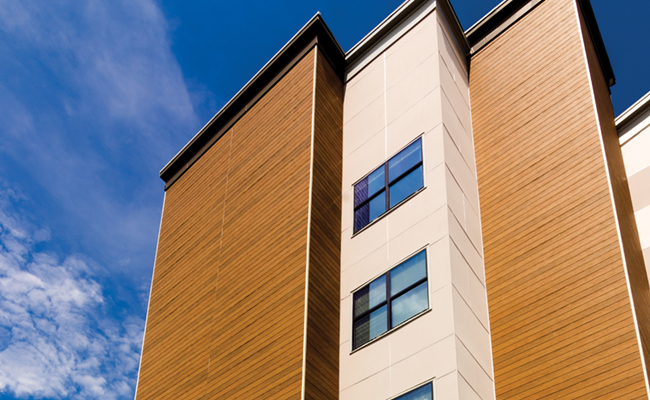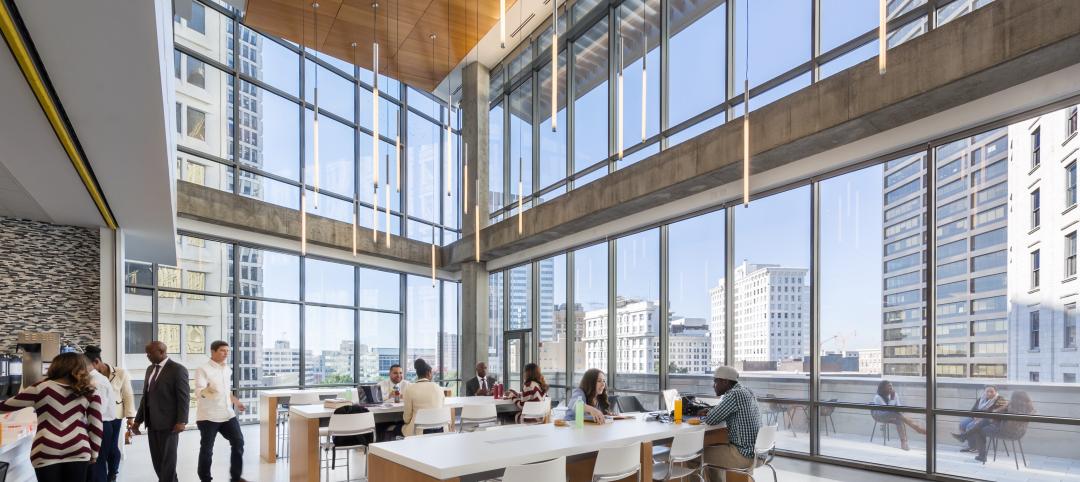Everyone loves the look of wood. It can instantly evoke a sense of tradition, yet also fit into the most modern of architectures. Wood can convey simultaneously that the building is absolutely a product of human thought and human effort, and is also tied to nature. It has been part of the built environment since the built environment was first built.
Despite other stronger, more durable and more formable materials developed over the years, wood has remained a visible part of buildings for its decorative value, and the ease with which it could be made into cladding. The oft-mentioned 'warmth' of wood is, therefore, both visual and psychological, an effect of both color and culture. The appearance of wood — the earth-bound colors, the irregularity of wood grain set within the regularity of millwork — and the deeply implanted associations we have with the material, makes it a rich and rewarding look with which to design.
On the other hand, owning natural wood, or being responsible for maintaining it, is not as rewarding an experience. It can be expensive to buy, install, and maintain. Exterior wood discolors, deteriorates, and gets attacked by rot, fungus, moss, and termites; it also warps, shrinks, splits, and requires high maintenance to keep its appearance anywhere near the design intent. While chemistry has made strides in protecting wood from the elements, even the best treatments must be renewed frequently, and they are not absolute proof against any of the material’s basic vulnerabilities.
Nonetheless, the appearance of wood still receives much attention from architects, with one reason being the increasing availability of substitutes for natural wood cladding that are more durable, affordable, and most important, aesthetically competitive. Fiber cement architectural wall panels impersonate wood brilliantly in appearance, and exceed it in performance. A long-lasting material that is impervious to most things that degrade natural wood, fiber cement panels are rot-proof, termite-proof, have good dimensional stability, are resistant to warping, and have very stable color finishes.
The visual effect of these panels is convincing, and designers and owners can have confidence in the visual effect. Even a company such as Whole Foods Market, whose brand depends heavily on its association with nature and unadulterated natural purity, uses fiber cement wood architectural panels on some of its stores. The availability of such cost-effective, high-performing wood cladding means the disadvantages of natural wood are no longer a barrier to envisioning wood in a Building Team’s design.
Related Stories
Sponsored | Healthcare Facilities | Aug 8, 2024
U.S. healthcare building sector trends and innovations for 2024-2025
As new medicines, treatment regimens, and clinical protocols radically alter the medical world, facilities and building environments in which they take form are similarly evolving rapidly. Innovations and trends related to products, materials, assemblies, and building systems for the U.S. healthcare building sector have opened new avenues for better care delivery. Discussions with leading healthcare architecture, engineering, and construction (AEC) firms and owners-operators offer insights into some of the most promising directions. This course is worth 1.0 AIA/HSW learning unit.
Sponsored | MFPRO+ Course | Oct 30, 2023
For the Multifamily Sector, Product Innovations Boost Design and Construction Success
This course covers emerging trends in exterior design and products/systems selection in the low- and mid-rise market-rate and luxury multifamily rental market. Topics include facade design, cladding material trends, fenestration trends/innovations, indoor/outdoor connection, and rooftop spaces.
Sponsored | Fire and Life Safety | Jul 12, 2023
Fire safety considerations for cantilevered buildings [AIA course]
Bold cantilevered designs are prevalent today, as developers and architects strive to maximize space, views, and natural light in buildings. Cantilevered structures, however, present a host of challenges for building teams, according to José R. Rivera, PE, Associate Principal and Director of Plumbing and Fire Protection with Lilker.
Sponsored | Building Enclosure Systems | May 16, 2023
4 steps to a better building enclosure
Dividing the outside environment from the interior, the building enclosure is one of the most important parts of the structure. The enclosure not only defines the building’s aesthetic, but also protects occupants from the elements and facilitates a comfortable, controlled climate. With dozens of components comprising the exterior assemblies, from foundation to cladding to roof, figuring out which concerns to address first can be daunting.
Sponsored | Cladding and Facade Systems | Mar 15, 2023
Metal cladding trends and innovations
Metal cladding is on a growth trajectory globally. This is reflected in rising demand for rainscreen cladding and architectural metal coatings. This course covers the latest trends and innovations in the metal cladding market.
Sponsored | Resiliency | Dec 14, 2022
Flood protection: What building owners need to know to protect their properties
This course from Walter P Moore examines numerous flood protection approaches and building owner needs before delving into the flood protection process. Determining the flood resilience of a property can provide a good understanding of risk associated costs.
Sponsored | BD+C University Course | Aug 24, 2022
Solutions for cladding performance and supply issues
This course covers design considerations and cladding assembly choices for creating high-performance building envelopes — a crucial element in healthy, energy-efficient buildings.
Sponsored | Multifamily Housing | May 8, 2022
Choosing the right paver system for rooftop amenity spaces
This AIA course by Hoffmann Architects offers best practices for choosing the right paver system for rooftop amenity spaces in multifamily buildings.
Sponsored | BD+C University Course | May 5, 2022
Designing with architectural insulated metal wall panels
Insulated metal wall panels (IMPs) offer a sleek, modern, and lightweight envelope system that is highly customizable. This continuing education course explores the characteristics of insulated metal wall panels, including how they can offer a six-in-one design solution. Discussions also include design options, installation processes, code compliance, sustainability, and available warranties.
















